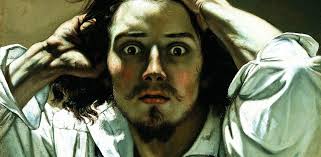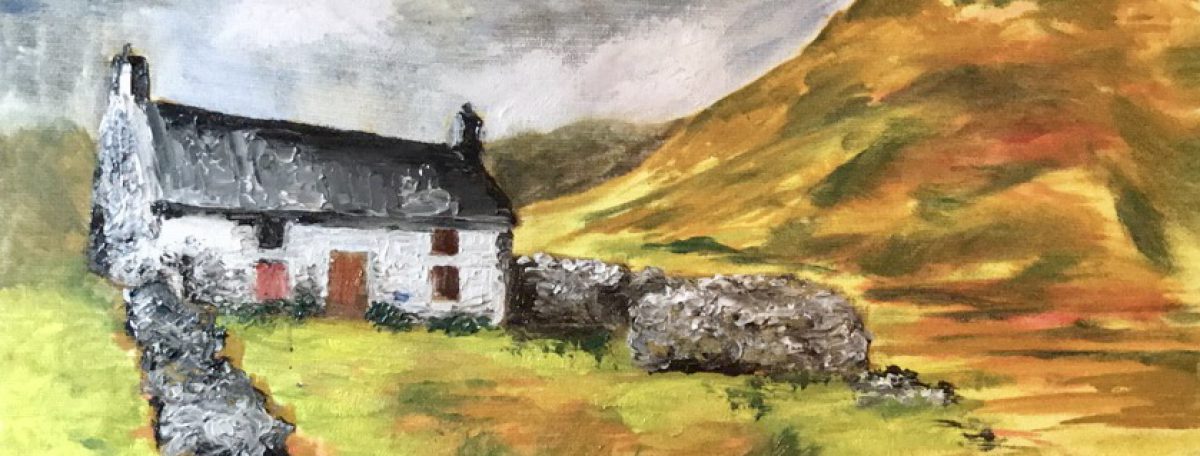My brief was to undertake some research into self-portraits of artists and to try and look at some examples across a broad time span and range of techniques.
I’ve been looking at the self-portraits of others whilst I have been undertaking the portrait exercises and have found a few artists, some of whom I was not really aware of, who I find really interesting. Some are artists discussed in feedback discussion with my tutor and some are artists who I have found when browsing and reading.
Joseph, Baron Ducreux (26 June 1735 – 24 July 1802)
Ducreux was a French noble and portrait painter, miniaturist and engraver at the court of Louis IX of France with a career that continued even after the French Revolution and death of the King. He was interested in producing portraits that looked beyond the traditional facial expressions used in portraiture. I found Ducreux through his self-portrait – “Portrait de l’artiste sous les traits d’un moqueur, Self-portrait, ca. 1793, which has been used in many a modern meme. The portrait always makes me smile.

https://www.wikiart.org/en/joseph-ducreux
My reading led me to what is possibly my favourite Ducreux painting – Self-portrait, yawning, ca. 1783.

http://www.getty.edu/art/collection/objects/600/joseph-ducreux-self-portrait-yawning-french-by-1783/
https://artsandculture.google.com/asset/self-portrait-yawning/MQG0zXDvoSnYDg
Ducreux seems to be having fun with this self-portrait which shows him stretching and yawning whilst wearing a casual outfit of bed cap/turban and brought red jacket. It’s a much exaggerated pose with his massive yawn and his arm stretched right into the viewer and makes me smile. I like the realism of the materials and the bright colours used against the darker background. He looks like he’s heading to bed and almost makes me yawn with him. I would think he wanted to produce something with a level of humour and demonstrate that you can produce a convincing self-portrait that is more informal and natural (despite the exaggeration).
Gustave Courbet (10 June 1819 – 31 December 1877)
Courbet found his career in a transitional period that saw Romanticism coming to a close and subsequently, the birth of realism and modernism in European visual culture. He led this Realism movement in 19th-century French painting, depicting only what he could see and setting an example important to later artists. Courbet’s 1840s self-portraits like “Desperate Man” however remind me of the style of Rembrandt and are painted in more of a romantic way, setting himself in different roles.

https://www.wikiart.org/en/gustave-courbet/the-desperate-man-self-portrait-1845
I am fond of this portrait as the romanticism and theatrical aspects appeal to me. He has a very modern (Johnny Depp-esque) style look and he does have a desperate, fearful expression in a very windswept, romantic and beautiful way. He fills the canvas, as a close up to his fear, clutching his dark hair. I love the lighting and the blush of his cheeks and lips as well as the strained sinews of his wrists as his hands dig into his hair. His eyes are fixed and seem to be at a point of terror or perhaps madness…
The attached article from the Fine Art Conniseur” (https://fineartconnoisseur.com/2017/06/portrait-of-the-week-gustave-courbet-the-desperate-man/) mentions suggestion that Courbet’s goal for this self-portrait was to “share the intensity of a moment in which the artist, having come to the end of his Romantic education and suddenly overcome at the spectacle of his imminent downfall, finds the strength to repudiate a destiny that is not his.” And “In this way, it proves to be a key work in the artist’s life, and it remained in his studio until his death” and was “Courbet’s chance to express what he had not done in his letters and his desire (to use his words), “to bury the amorous follies of my youth.”” So this is Courbet’s move from Romanticism to Realism. If that is the case, I think it is a successful and clever way to draw a line and move forward.
This portrait has inspired me in terms of the forthcoming exercise on “Conveying Character” (to be covered later in my blog).
Frida Kahlo (6 July 1907 – 13 July 1954)
Kahlo was a prolific Mexican painted and portrait artist who painted many self-portraits in her life, inspired by the nature and cultural artefacts around her, in a folk art style. Her works explored themes around identity, post colonialism, gender, class, and race in Mexican society and were often autobiographical but blended realism with fantasy.
I love Kahlo’s portraits as I know many do. The colours and the imagery are brilliant and she is there at the centre of it all, looking proud and strong in her traditional indigenous Mexican peasant clothing. Her health was fragile, following a near-death childhood traffic accident left her incapacitated and in a plaster corset for many months. Kahlo gave up her dream of becoming a doctor, considering a career of medical illustration which would combine a love of science and art and she set up a mirror and began to paint and explore herself and some of themes that would follow in her work throughout her career. In 1928, Kahlo was introduced to the older Diego Rivera, one of Mexico’s most successful artists who would become her husband.
There are some wonderful Kahlo portraits of her in nature with the creatures she loved but I am drawn to the self-portrait she painted at the end of her life (below) which shows a frail but relaxed Kahlo with her long, flowing hair loose. I love her direct stare and the determined set of the mouth. She was actually 40 years old at the time but the scroll at the bottom of the painting reads:
“Here I painted myself, Frida Kahlo, with my reflection in the mirror. I am 37 years old and this is July, 1947. In Coyoacan, Mexico, the place where I was born”.

https://www.fridakahlo.org/self-portrait-with-loose-hair.jsp
The painting reinforces her identity even down to the town she was from and clearly seeks the admiration of her ex husband in terms of his declared love of her beautiful, loose hair. This was so important to him. In the lead up to her divorce from Rivera she had cut off her hair and painted Self-Portrait with Cropped Hair littering the portrait with tresses of her cut hair.
Kahlo’s portraits resonate with me as there is suffering but also determination. She shows herself as a realistic figure, confident in her identity and there is a consistent style and use of colour in her work which makes her very distinctive.
Tracey Emin CBE, RA (B. 1963)
Emin is an English artist known who produces work with autobiographical and confessional themes. She works in a variety of media – drawing, painting, sculpture, film, photography, neon text and sewn appliqué. Emin is now a Royal Academician of the Royal Academy of Arts.
I hold my hand up here and say that I am no fan of Emin’s work – I just don’t really get it. She is controversial and sometimes funny, but I can’t really say I particularly like anything she’s done (but what do I know!?). She is however highly recognised for introducing unpopular themes into her work and poking society with a stick, so to speak, so I have to admire her for that alone. If it gets a reaction, even a negative one, it’s better than being dull I suppose. Her confessional works are based on her own (often negative) life experiences and she often uses her own body as subject for works. She does however introduce a lot of honesty and humour into her work, which I do like. The self-portrait below is actually a very good likeness of Emin and there is definitely a spark of humour there that makes me smile back at her. I was also amused to find a portrait of Emin as Frida Kahlo by Suffolk Artist & Illustrator Allan Williams which made me chuckle. I wonder what Kaho would have made of that. There were common themes around identity and gender which might maybe have resonated.
https://www.tate.org.uk/art/artists/tracey-emin-2590
http://www.allanwilliams.net/portraits/tracey-emin-frida-kahlo
Reflections from my research to date:
I do find myself drawn to humour, from Ducreux’s exaggerated portraits, through to Tracey Emin’s wry smile and I do have quite a dark sense of humour, which I am sure will come into play in the future. It isn’t something I have intentionally used up to now, to help bring forward any themes or issues but think that is a possibility (I am just not sure what and how at this early part of my journey).
Courbet has already inspired a self-portrait I am working on around conveying character. The focus on this painting has made me realise how talented he was. The depiction of the lighting, flesh tones and emotional expression is really difficult to achieve (but he makes it look very easy!). Practice is the way forward I think.
I am most drawn to Kahlo and I think this is because of her cultural identity and her love of nature and art as well as, of course, the health issues she battled with during her short life (she was a year younger than me when she died). I would be most likely to have a Kahlo painting on my wall, not just because of the subject or vibrant and bold colours and shapes. I feel I understand her.
I am generally not attracted to Emin’s work in any way. I don’t really like the way she sometimes behaves and how she chooses to put her contraversial messages over. To me, she is the art equivalent of that embarrassing friend who often gets drunk and then spills too much about her life to an audience. However she is open, honest and vulnerable in terms of what she chooses to display to the world. For me though, this is done a little too desperately and perhaps she is trying a bit too hard to shock. Though I admit I don’t like her brash approach to her art, I admire her for putting her own issues out there and for the wry humour she often puts into her work.


